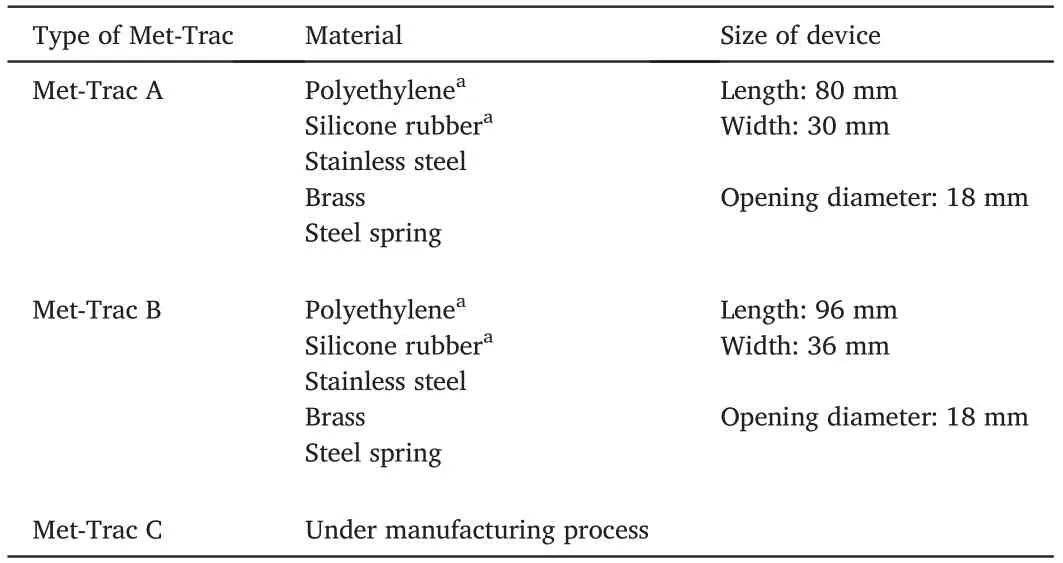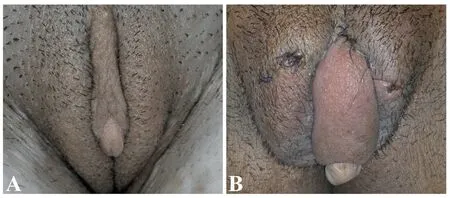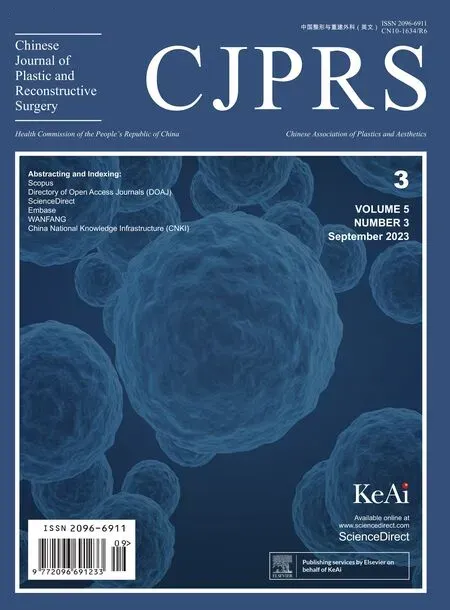Eight-year follow-up on postoperative improvement protocol in extensive metoidioplasty transgenders: A case series
Shahryar Cohanzad
Pars Advanced and Minimally Invasive Medical Manners Research Center, Pars Hospital, Iran University of Medical Sciences, Rastak St., Shahid Abdollahzade Ave.,Keshavarz Blvd., Tehran 1415944911, Iran
Keywords:Gender identity disorder Metoidioplasty Sex reassignment surgeries Transsexualism Penile extender Penile traction device
A B S T R A C T
1.Introduction
Metoidioplasty, despite being a popular technique in penile reconstructive surgery, has been criticized for its unsatisfactory final penile size results.Extensive Metoidioplasty (EM),1our modification of the original technique, was introduced in 2016 and has been practiced for more than 25 years at our center.EM is capable of producing a fully sensate, larger, and hence more acceptable penis, especially in conjunction with its associated Penile Improvement Protocol(PIP).2PIP was also first introduced in 2016.
Although several modalities,such as vacuum devices,penile traction devices(PTDs),3rings,and various other techniques for lengthening the penis, are available, owing to the relatively small size of the neo-penis,none of these could benefit our patients.Therefore, we designed a new device to accommodate the smaller size that is associated with the neo-penis.Continuous traction results in cellular proliferation and expansion of the extracellular matrix.4This idea was first used in stimulation,remodeling,and lengthening of the bones and was subsequently applied to other tissues such as muscles, scars,5tendons, and collagen.6These findings are supported by histological examinations,7and the results of Gontero et al.’s studies.8
In 2016, we succeeded in showing the efficacy of PIP in EM in 14 patients.According to the study’s design, the effectiveness of this protocol was investigated over a 6-month follow-up period.Therefore, it seemed wise to evaluate the effectiveness of EM over a longer period.Here,we present the results of our eight-year study in seven out of the 14 patients who were included in the original study.2
2.Methods
2.1.Device
Our exclusively designed device,Met-Trac(a name derived from the words metoidioplasty and traction), is made of polyethylene, silicone rubber,stainless steel, and brass.2Met-Trac is fully tissue compatible in parts of the device that are in contact with the skin.The device was designed in two different sizes,Met-Trac A and Met-Trac B,with lengths of 80 mm and 96 mm, widths of 30 mm and 36 mm, and opening diameters of 18 mm and 22 mm,respectively.The average manufacturing cost is$40 each(Table 1,Fig.1).
In the present study, all participants used Met-Trac B because of the increase in penile length that was achieved in the previous one.2Met-Trac B,which is similar to Met-Trac A,consists of a resting headset,two dynamically adjustable rods,and an elastic strapping band.The rodsare assembled with two adjusting screws and the band is supported by two braces, enabling the device to adjust appropriately to the required tension and maintain the stability of the penis within device2(Fig.1).

Table 1 Specifications of different types of Met-Trac.
2.2.Participants
Seven out of 14 patients in the preliminary study were enrolled in this study between 2015 and 2023.The participants had a mean age of 29.71 ± 13.76 years (Table 2).Five participants were transsexuals(46XX karyotype, DSM-4 criteria), and two participants had documented 5-alpha-reductase deficiency syndrome(Table 4).The patients were followed up at a specialized sexual dysfunction clinic of a general hospital in Tehran, Iran.
All participants underwent EM (Fig.2), either as a sex reassignment surgery(SRS)or inter-sex genital-rectifying procedure.Participants 5,7,8,9,and 12 continued to use the device as recommended after the end of the first study (Fig.3).While the other patients did not follow the protocol exactly as directed, two participants (P2 and P11) did not use the device at all (Table 3, Fig.4).Informed consent was obtained from all participants after a comprehensive explanation of the nature,objectives,benefits, cost, duration, projected outcomes, and shortcomings of the study.They also completed a questionnaire to provide information on the extent and quality of the practice they implemented in performing the protocol between 2015 and 2023(Supplementary Table 1).
Eight years after their last visit to the clinic, the participants’ penile lengths were measured (Pubo-Mid-Glandular Length (PMGL)) using a Vernier caliper (Fig.2).The measurement session was conducted by skilled personnel,avoiding any erroneous measurements.
2.3.Penile improvement protocol
All participants fulfilled the following PIP protocol during the preliminary study in 2015:PIP was initiated by the application of Met Trac-A for 2 h daily at full stretch capacity of the penis, with increments of at least 2 mm every 2 weeks.In accordance with the participants’ compliance, the duration of traction was gradually increased daily to a maximum of 6 h/day.The procedure was performed for at least 24 weeks,and strict adherence to the protocol was recommended.
Regular clinic visits were scheduled every 2 weeks; during this, all patients were questioned about the occurrence of any complications,the presence or absence of sexual intercourse with reference to satisfaction with intercourse,and the size of the penis.In addition,at every visit,the PMGL was measured in a less than fully stretched penile state using a Vernier caliper.The application of PIP and close follow-up of all participants continued for a minimum of 24 weeks(Table 3,Fig.4).
3.Results
On arrival at the clinic, all participants were carefully measured for PMGL; the increments in comparison to 2015 values were registered accordingly.Five patients who had used the device showed an increase in penile length (P5=34 mm, P7=28 mm, P8=12 mm, P9=23 mm, and P12=48 mm;mean,29.00±13.34 mm)(Figs.5 and 6).The remaining two patients did not show such an increase in penile length(P2=0 mm,P11=-1 mm) (Table 3,Fig.4).
None of the patients reported complications.All the participants were personally aware of an increase in penile length and had sexual intercourse at least occasionally.All participants considered the increase in penile length to be involved in the better quality of sexual intercourse.
Two participants who refused to continue using the device showed high degrees of penile dysmorphophobia (body dysmorphic disorder(BDD)/DSM-5 criteria) that prevented them from having a satisfactory self-image even after the surgery.These two participants also demonstrated the possible presence of such a disorder in their answers to the first questionnaire of the first study.
All participants who had sexual intercourse used sildenafil citrate at least occasionally(25–50 mg,45 min prior to sexual contact).At the time of writing the article, P12 was using a larger, commercially available traction device because of the significance of the increase in penile length that the patient has gained.Four other participants will also use the larger version of Met-Trac once available(Met-Trac C)(Table 1).
4.Discussion
Many studies have demonstrated the effects of stretching on tissue expansion.Long necks of the Kayan tribal women or Mursi’s lips are among the known examples.9,10In one study, Brava was shown to produce a temporary increase in breast size,generating a large fibrovascularscaffold to prepare the breast for future autologous fat graft procedures.11Moreover, various cultures, especially those in which patriarchy hasplayed a major role,have developed several methods to increase the size of the penis.One such method is that which is practiced traditionally by the people from Arabian countries and is termed“Jelqing”.It should be noted that such behaviors are not limited to old or traditional societies but are also practiced widely in today’s urban and modern life.These practices are popular with male sex therapists worldwide.

Table 2 Patient ages in 2015 and 2023.

Fig.1.Met-Trac.

Fig.2.P2.(A) Preoperation.(B) Postoperation.

Fig.3.Transformation from the 6th through 24th weeks.(A)Week 6.(B)Week 16.(C) Week 24.

Table 3 Detailed follow-up information during the course of the study (from 2015 to 2023).

Table 4 Patients’ underlying diseases.
Scientific evidence for nonsurgical approaches to penile enlargement is scarce.Therefore,the design of a nonsurgical,cost-effective,and easyto-use technique to increase the size of the neo-penis in patients who have undergone metoidioplasty could be quite practical and effective.Numerous devices and systems that are advertised on the market,such as penile traction devices, extenders, and stretchers, claim to enlarge the penis.Their physical mechanisms are similar and consist of two adjustable rods:a resting headset and an elastic band.By placing the glans on the headset and buckling it with an elastic band,the penis is subjected to progressively increasing traction that is controlled by the adjustable rods.In a study conducted in Turkey,a penile traction device was used to treat patients with Peyronie’s disease.The study showed that this device,especially when used concomitantly with intralesional injections of both verapamil and interferon alpha-2b, led to a significant increase in stretched penile size compared with that of controls, suggesting the potential efficacy of the device.12,13
Metoidioplasty,a technique for the construction of the penis from its most compatible analog, the clitoris, has been criticized for its final penile size results.Multiple publications have introduced the basics of penile enlargement techniques and modification of metoidioplasty.14Conventional metoidioplasty is popular primarily because of its cost-effectiveness, lack of scarring outside the genital area, single-stage execution, and subsequent postoperative phalloplasty,if needed.
We modified the technique in an extreme fashion and achieved larger penile sizes by performing a near-complete dissection of the proximalmost part of the clitoris from its attachment to the pubic arch.The crura are then approximated,giving rise to additional lengthening of the penis.Despite the overall promising results of our exclusive technique,some patients’realistic expectations for the operative procedure remain unmet.
The integral part of preoperative patient preparation at our clinic is delving into unrealistic expectations that may arise concerning the results of this surgery.The closer our patients are to a realistic expectation from our capabilities,the more compliant they will be with appreciating EM as well as long-term postoperative follow-up and management.

Fig.4.Overall comparison between the results of patients who used Met-Trac B and patients who did not use Met-Trac B.

Fig.5.P12.Overall transformation of neo-penis in 2015 and 2023.(A) 2014.(B) 6 months postoperatively.(C) 2015.(D) 2023.
It has been almost 25 years since, in addition to EM, PIP became an integral step in the management of patients who have undergone surgery in addition to EM, and we have documented satisfactory outcomes in penile lengthening in this population through our previous article.2These results must be interpreted in light of performing these procedures in a highly controversial field and traditional society.Generally speaking,insufficient or, even worse, fake information on different aspects of transsexualism and what might be possible by surgery in the transsexual population in Iran has given rise to various degrees of unrealistic patient perceptions,to the extent that some patients expect nothing less than an enormously large penis to consider themselves normal.It is essential to educate patients by following the instructions and recommendations as strictly as possible.In the current study,there were two participants who,according to the questionnaires taken in the course of both articles,suffered from BDD.Interestingly,these two patients showed less interest in active and motivated participation in the continued application of the device.

Fig.6.P2.Overall transformation of neo-penis in 2015 and 2023.(A)2012.(B)One week postoperatively.(C) 2015.(D) 2023.
As was the case in our previous study, we intentionally did not include penile girth measurements because of the lack of an appropriate device to reliably measure small circumferential sizes and the difficulty of recording and following negligible changes that could occur.Nevertheless, based on our observations, there have also been increases in patients’ penile girth.However, this observation should be tested in future studies.
We were unable to compare the efficacy of Met-Trac to other devices that are currently available on the market,mainly because of the lack of scientific data for their use in this particular patient population.The lack of applicable devices was our major incentive to manufacture a compatible device for this group of patients.In our previous article, we succeeded in showing the efficacy of PIP.In the present study, we assessed the potential improvement effect of the same procedure over a longer period of time.Fortunately, we still had enough motivated patients from the same group of participants in the first study to design and execute a retrospective review of the issue.A finding that warrants attention in this study is that the potential role of the presence or absence of BDD in this group of patients and its possible relationship to the final satisfaction rate of the treatment was presented.Possibly,the existence of such an underlying disorder may affect the patient’s motivational aspects, active participation, and, hence, final satisfaction rate.Interestingly, there were two patients with BDD, neither of whom were sufficiently motivated to adhere to the protocol.Medical body modification is highly recommended in patients with gender dysphoria,unlike those with BDD, especially from point of view that performing such modifications is contraindicated in body dysmorphic patients15; however, further investigations are needed in this regard.At the time of writing this article,our center was conducting a study on the incidence of such underlying disorders in patients with gender dysphoria and its potential role in the treatment process in this group of patients.We hope that this future study provides enlightening, reliable, and informative findings.
5.Conclusion
The long-term implementation of PIP can result in larger penile size in patients undergoing metoidioplasty.We advise demanding and highly motivated patients to continue practicing PIP to achieve better results.Because of the complexity of the treatment of patients with gender identity disorders,we believe that there is room for further endeavors to improve the quality of care for these patients.
Ethics approval and consent to participate
This study was performed in line with the principles of the Declaration of Helsinki.Approval was granted by the Ethics Committee of Beheshti University of Medical Sciences (IR.SBMU.ENDOCRINE.REC.1401.123).All participants provided written informed consent before study enrolment.
Consent for publication
Informed consent was obtained from all participants for publication of the data contained within this study.
Declaration of competing interests
The authors declare that they have no competing interests.
Acknowledgments
Special thanks to Fahimeh Ramezanzadeh Tehrani, Professor of obstetrics and gynecology, Beheshti University of Medical Sciences,Tehran/Iran; Mehran Kouchek, Associate Professor, Beheshti University of Medical Sciences, Tehran/Iran; Shahla Chaichian, Professor of obstetrics and gynecology, fellowship in MIS, Iran University of Medical Sciences, Tehran/Iran.
Supplementary data
Supplementary data to this article can be found online at https://doi.org/10.1016/j.cjprs.2023.08.003.
 Chinese Journal of Plastic and Reconstructive Surgery2023年3期
Chinese Journal of Plastic and Reconstructive Surgery2023年3期
- Chinese Journal of Plastic and Reconstructive Surgery的其它文章
- Application of a jigsaw puzzle flap based on free-style perforator to repair large scalp defects after tumor resection: A case series
- Absolute ethanol embolization for treatment of peripheral arteriovenous malformations
- Efficacy of tibial transverse transport combined with platelet-rich plasma versus platelet-rich plasma alone in the treatment of diabetic foot ulcers: A meta-analysis
- Efficacy, effectiveness, and safety of combination laser and tranexamic acid treatment for melasma: A meta-analysis
- A randomized clinical trial assessing the efficacy of single and multiple intralesional collagenase injections for treating contracted scars
- Integrated percutaneous sclerotherapy and surgical intervention for giant cutaneomucosal venous malformation from TIE2 mutation: A case report
